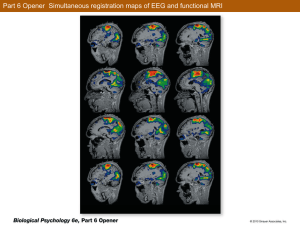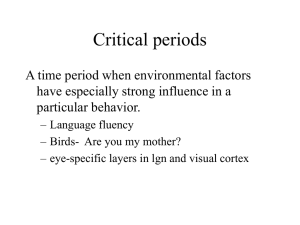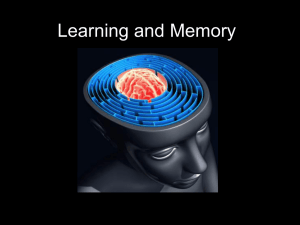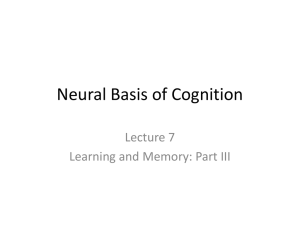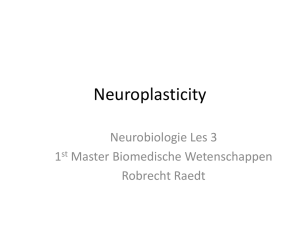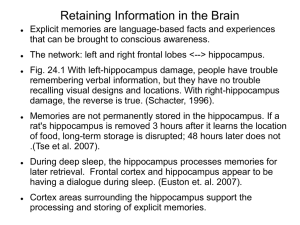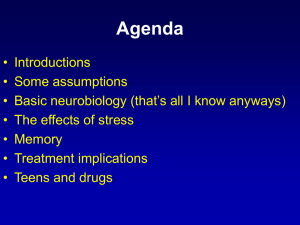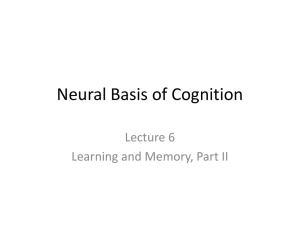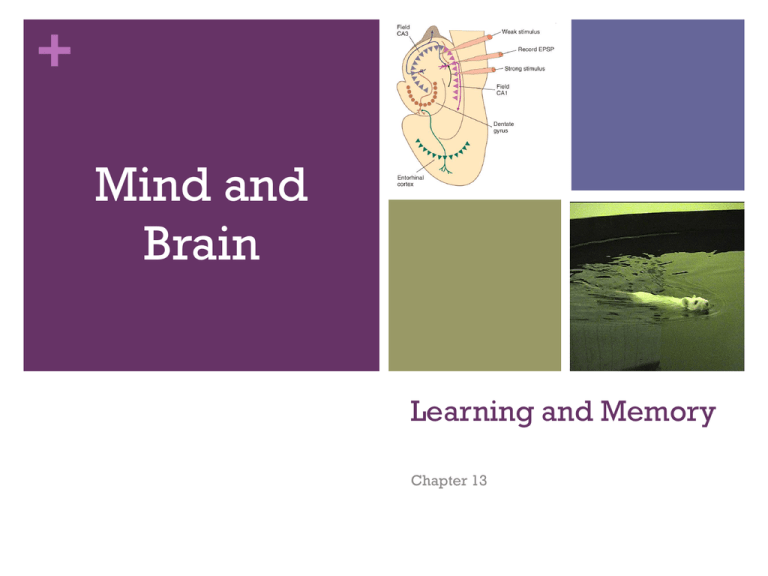
+
Mind and
Brain
Learning and Memory
Chapter 13
+
You
are responsible for
Chapter 13 (text and notes)
for you final as well as all
other chapters (and notes)
covered in class.
+
http://www.youtube.com/watch?v=JliczINA__Y&feature=relat
ed
+
Chapter Overview
The Nature of Learning
Synaptic Plasticity: Long-Term Potentiation and Long-Term
Depression
Perceptual Learning
Classical Conditioning
Instrumental Conditioning
Relational Learning
+
The Nature of Learning
Introduction
Learning refers to the process by which experiences change
our nervous system and hence our behavior; we refer to these
changes as memories
Experiences are not stored – they change the way we perceive,
perform, think, and plan
They do so by physically changing the structure of the nervous
system, altering neural circuits that participate in perceiving,
performing, thinking and planning.
+
The Nature of Learning
Learning
can take at least 4 basic forms
Perceptual Learning
Stimulus-Response Learning
Classical Conditioning
Instrumental Conditioning
Motor Learning
Relational Learning
+
The Nature of Learning
Perceptual
Learning
Learning to recognize a particular stimulus
Primary function: ability to identify and categorize
objects and situations
Each sensory system is capable of perceptual learning
Accomplished by changes in the sensory association
cortex
+
The Nature of Learning
Stimulus-Response
Learning
Learning to automatically make a particular response in
the presence of a particular stimulus
Involves the establishment of connections between circuits
involved in perception and those involved in movement
Classical conditioning
Instrumental conditioning
+
The Nature of Learning
Classical
Conditioning
Unconditional Stimulus (US) – stimulus that produces a
defensive or appetitive response.
Unconditional Response (UR) – response to the US.
Conditional Stimulus (CS) – stimulus, which when paired
with the US during training, comes to elicit a learned
response.
Conditional Response (CR) – response to the presentation
of the CS.
+ Figure 13.1 A Simple Neural Model of
Classical Conditioning
+
The Nature of Learning
Hebb
Rule
hypothesis proposed by Donald Hebb that the cellular
basis of learning involves strengthening of a synapse that
is repeatedly active when the postsynaptic neuron fires.
+ Figure 13.1 A Simple Neural Model of
Classical Conditioning
+
The Nature of Learning
Instrumental
Conditioning (Operant conditioning)
learning procedure whereby the effects of a particular behavior in a
particular situation increase (reinforce) or decrease (punish) the
probability of the behavior.
Reinforcing Stimulus – appetitive stimulus that follows a particular
behavior and thus makes the behavior become more frequent.
Punishing Stimulus – aversive stimulus that follows a particular
behavior and thus makes the behavior become less frequent.
CC involves automatic or species-typical responses, but OC
involves behaviors that have to be learned
CC involves an association between 2 stimuli, OC involves an
association between a response and a stimulus.
OC is considered more flexible because it permits an organism to
adjust its behavior according to the consequences of that
behavior.
+ Figure 13.2 A Simple Neural Model of
Instrumental Conditioning
+
The Nature of Learning
Motor Learning
Learning to make a new response
Component of stimulus-response learning
+ Figure 13.3 An Overview of Perceptual,
Stimulus-Response (S-R), and Motor
Learning.
+
The Nature of Learning
Relational
Learning
More complex form of learning
Involves learning the relationships among individual
stimuli
Includes the ability to recognize objects through more
than one sensory modality
Involves learning the relative location of objects in the
environment – spatial learning
Remembering the sequence in which events occurred
during particular episodes – episodic learning
Hippocampus
+
Chapter Overview
The Nature of Learning
Synaptic Plasticity: Long-Term Potentiation and Long-Term
Depression
Electrical stimulation of circuits within the hippocampus can lead
to long-term synaptic changes that seem to be responsible for
learning
Perceptual Learning
Classical Conditioning
Instrumental Conditioning
Relational Learning
+
See Figure 13.4
Primary input to the HF comes
from the EC
Axons of EC neurons pass
through the perforant path and
synapse with granule cells in the
DG
From these cells, the mossy
fibers project to the pyramidal
cells in CA3
From CA3, Schaffer collaterals
project to CA1 cells
The 3 synapses know as the
trisynaptic loop
+
Induction of LTP
A stimulating electrode is
placed in the PP and a recording
electrode is placed in the DG
A single pulse of electrical
stimulation is delivered to the PP
and the resulting population
EPSP is recorded in the DG
Population EPSP is the evoked
potential that represents EPSPs
of a population of neurons.
LTP can be induced by
stimulating the PP axons with a
burst of electrical pulses (i.e.,
100) within a few seconds
+
LTP
The size of the first population EPSP tells us the strength of
the synaptic connections before LTP is induced
Evidence that LTP has occurred is obtained by periodically
delivering a single pulse and then measuring the response
in the DG to see if it is bigger than the original response
+
Synaptic Plasticity: LTP and LTD
LTP
Can be induced in other parts of the HF and in other
brain regions
Can last for several months
Can be induced in slices and in living animals
Can follow the Hebb Rule (in slices)
Associative Long-Term Potentiation – long-term potentiation
in which concurrent stimulation of weak and strong synapses
to a given neuron strengthens the weak ones.
+ Figure 13.6 Associative Long-Term
Potentiation
+ Figure 13.7 The Role of Summation in LongTerm Potentiation
Nonassociative LTP requires an
additive effect
Series of pulses delivered at
high rate will produce LTP
Same # of pulses given at slow
rate will not (LTD)
Rapid rate of stimulation causes
EPSPs to summate
Rapid stimulation depolarizes
the postsynaptic membrane
more than slow stimulation
+ Figure 13.8 Long-Term Potentiation
Experiments have shown that
synaptic strengthening occurs
when NTS binds with
postsynaptic receptors located
in a dendrite that is already
depolarized
LTP requires 2 events
Activation of synapses
Depolarization of the
postsynaptic membrane
+
Synaptic Plasticity: LTP and LTD
Role of NMDA Receptors
NMDA Receptor – specialized ionotropic glutamate receptor that
controls a calcium channel that is normally blocked by Mg2+
ions.
Calcium ions enter the cells through channels controlled by
NMDA receptors only when glutamate is present and the
postsynaptic membrane is depolarized
+ Figure 13.9 The NMDA Receptor
+
Synaptic Plasticity: LTP and LTD
Role of NMDA Receptors
AP5 – 2-amino-5-phosphonopentanoate, a drug that blocks NMDA
receptors.
Blocks the establishment of LTP
+
Synaptic Plasticity: LTP and LTD
Need glutamate & depolarization….but how do dendrites
become depolarized if only axons can produce action
potential?
Dendritic Spike – action potential that occurs in the dendrite of
some types of pyramidal cells.
Threshold for activation is very high
Only occurs when action potential is triggered in the axon
Backwash of depolarization across cell body triggers dendritic
spike
Whenever the axon of a pyramidal cell fires, all of its
dendritic spines become depolarized for a brief time.
+
Synaptic Plasticity: LTP and LTD
Simultaneous occurrence of synaptic activation and
a dendritic spike strengthens the active synapse.
Magee and Johnston (1997) injected individual CA1
pyramidal cells in hippocampal slices with a fluorescent dye
that permitted them to see the influx of calcium
When individual synapses became active at the same time
that a dendritic spike had been triggered, Ca “hot spots”
occurred near the activated synapses
Size of EPSPs produced by these activated synapses became
larger – synapse became strengthened
TTX (blocks Na current) injected near dendrite – prevented
dendritic spikes, no LTP!
+
Synaptic Plasticity: LTP and LTD
Role of NMDA receptors in Associative LTP
If weak synapses are active by themselves, nothing happens
(NMDA receptors don’t open)
However, if the activity of strong synapses located elsewhere on
the postsynaptic cell has caused the cell to fire, then a dendritic
spike will depolarize the postsynaptic membrane enough to eject
Mg ions from the Ca channels (of NMDA receptor)
If some synapses then become active, Ca will enter the dendritic
spines and cause the synapses to become strengthened
+
Synaptic Plasticity: LTP and LTD
What
is responsible for the increase in synaptic
strength that occurs during LTP?
Dendrites
on CA1 neurons contain 2 types of
glutamate receptors: NMDA and AMPA
+
Synaptic Plasticity: LTP and LTD
Mechanisms
of Synaptic Plasticity
AMPA Receptors – ionotropic glutamate receptor that
controls a sodium channel; when open it produces EPSPs.
Strengthening of individual synapses is accomplished by
the insertion of more AMPA receptors into the
postsynaptic membrane of the dendritic spine
CaM-KII – type of calcium-calmodulin kinase, an enzyme
that must be activated by calcium; may play a role in the
establishment of LTP.
Nitric Oxide Synthase – enzyme responsible for the
production of nitric oxide.
Drugs that block this enzyme prevent the establishment
of LTP in CA1
+ Figure 13.16 Chemistry of LTP
Activation of terminal button
releases glutamate, which binds
with NMDA receptors in the
postsynaptic membrane of the
dendritic spine
If the membrane was depolarized
by a dendritic spike, then calcium
ions enter and activate CAM-KII
CAM-KII travels to the
postsynaptic density and causes
the insertion of AMPA receptors
LTP also initiates changes in
synaptic structure and production
of new synapses
+ Figure 13.16 Chemistry of LTP
The entry of calcium also
activates NO synthase
This produces NO which diffuses
out of the dendritic spine and
back to the terminal button
The NO may then trigger
chemical reactions that increase
the release of glutamate
Long-lasting LTP also requires the
synthesis of new proteins and the
presence of dopamine
+
Synaptic Plasticity: LTP and LTD
Low-frequency stimulation of the synaptic inputs to a cell can
decrease their strength
Long-Term Depression (LTD) also plays a role in
learning…some synapses are strengthened and others
weakened
long-term decrease in the excitability of a neuron to a particular
synaptic input caused by stimulation of the terminal button while
the postsynaptic membrane is hyperpolarized or only slightly
depolarized.
Like LTP, requires activation of NMDA receptors
LTD involves a decrease in AMPA receptors
+
Synaptic Plasticity: LTP and LTD
Other Forms of LTP
Some forms of LTP do not involve NMDA receptors and are not
blocked by AP5 (CA3).
For example, mossy fiber input from dentate gyrus to CA3
Presynaptic changes only – no alterations in structure of dendritic
spines
+
Chapter Overview
The Nature of Learning
Synaptic Plasticity: Long-Term Potentiation and Long-Term
Depression
Perceptual Learning
Classical Conditioning
Instrumental Conditioning
Relational Learning
+ Figure 13.18 The Major Divisions of the
Visual Cortex of the Rhesus Monkey
Primary visual cortex receives
information from the lateral
geniculate nucleus of the
thalamus
Ventral Stream – pathway of
information from the primary
visual cortex to the temporal
lobe, which is involved in
object recognition (‘what’
pathway).
Dorsal Stream – pathway of
information from the primary
visual cortex to the parietal
lobe, which is involved with
perception of the location of
objects (‘where’ pathway).
+
Chapter Overview
The Nature of Learning
Synaptic Plasticity: Long-Term Potentiation and Long-Term
Depression
Perceptual Learning
Classical Conditioning
Instrumental Conditioning
Relational Learning
Figure 13.21 Conditioned Emotional
+ Responses
Information about the CS &
US converge in the LA so
synaptic changes responsible
for learning could take place
in this area
Hebb rule - weak synapses
(from tone) are strengthened
when US activates neurons in
the LA….LA neurons fire and
activate CN …which evokes
the response (Ch 11)
+
Classical Conditioning
Evidence for the involvement of lateral nucleus of the
amygdala in CER
Changes in the LA responsible for CER learning involve LTP…and
is accomplished through activation of the NMDA receptor
LTP
Injection of drugs that block LTP into the amygdala prevents the
establishment of conditioned emotional responses
CER training (tone-shock pairings) causes AMPA receptors to
be driven into dendritic spines of synapses between LA
neurons and axons that provide auditory input
+
Classical Conditioning
Rumpel et al., (2005) used a virus to insert a gene for a fluorescent dye
coupled to a subunit of the AMPA receptor into the LA of rats…learning
caused AMPA insertion
They also inserted a gene for a dye
coupled to a defective subunit of the AMPA
receptor…the defective subunit prevented
AMPA insertion and conditioning did not
take place
+
Classical Conditioning
Infusion of many drugs into the LA that prevent LTP disrupt
acquisition of a CER
Conclusion:
LTP in the amygdala, mediated by NMDA receptors, plays a
critical role in the establishment of CER
+
Chapter Overview
The Nature of Learning
Synaptic Plasticity: Long-Term Potentiation and Long-Term
Depression
Perceptual Learning
Classical Conditioning
Instrumental Conditioning
Relational Learning
+
Instrumental Conditioning
Instrumental conditioning involves a connection between a
particular stimulus and a particular response
2 major pathways between sensory association cortex and motor
association cortex
Direct transcortical connections
Involved in episodic memory (along with HIP)
Connections via the basal ganglia and thalamus
2 pathways play different roles
+
Basal Ganglia
Learned behaviors become automatic and routine, they are
transferred to the basal ganglia
Leaving the transcortical circuits free to learn new tasks
+ Figure 13.23 The Basal Ganglia and Their
Connections
•Neostriatum (caudate nucleus
& putamen) receives sensory
input from all regions of the
cerebral cortex. Also receives
information from frontal lobes
about movement (planned or in
progress).
•Outputs are sent to GP which
sends information back to
frontal cortex to premotor cortex
(where plans for movement are
made) and motor cortex (where
movement is executed)
+
Instrumental Conditioning
Basal Ganglia
Studies of laboratory animals have indicated that:
lesions of the basal ganglia disrupt instrumental conditioning
without affecting other forms of learning.
Lesions did not disrupt visual perceptual learning
Impaired the monkeys’ ability to learn to make a visually guided
operant response
Williams and Eskandar (2006): as monkeys learned a operant
response, the rate of firing of single neurons in the caudate nucleus
increased
Fernadez-Ruiz et al., (2001) destroyed portions of the caudate and
putamen that receive visual information from the ventral stream
The activity of caudate neurons is correlated with rate of learning
Blocking NMDA receptors in the basal ganglia with an injection of
AP5 disrupts learning guided by a simple visual cue
+ Instrumental Conditioning Reinforcement
Neural circuits involved in reinforcement discovered by Olds
& Milner, 1954.
Reinforcement
Neural Circuits Involved in Reinforcement
Ventral Tegmental Area (VTA) – group of dopaminergic
neurons in the ventral midbrain whose axons form the
mesolimbic and mesocortical systems and are important in
reinforcement.
Nucleus Accumbens – nucleus of the basal forebrain near the
septum; receives dopamine from neurons of the VTA and is
thought to be involved in reinforcement and attention.
See Figure 13.24
Figure 4.13 Dopaminergic Pathways in a Rat Brain
+
Instrumental Conditioning
Reinforcement
Microdialysis studies have revealed that release of DA in the NA is
caused by:
reinforcing electrical stimulation of the medial forebrain bundle
(connects VTA to NA) or the VTA
administration of cocaine or amphetamine
presence of natural reinforcers such as water, food, sex partner
fMRI indicates activity in NA during reinforcing events
+
Instrumental Conditioning
Functions of the Reinforcement System:
To detect reinforcing stimuli.
To strengthen the connections between the neurons that
detect the discriminative stimulus (i.e., sight of lever) and
the neurons that produce the instrumental response (i.e.,
lever press).
+
Instrumental Conditioning
Reinforcement occurs when neural circuits detect a
reinforcing stimulus and cause the activation of
dopaminergic neurons in the VTA
A stimulus that serves as a reinforcer on one occasion may
fail to do so on another
Reinforcement system is not automatically activated when
particular stimuli are present; activation also depends on the
state of the animal
+
Instrumental Conditioning
Detecting reinforcing stimuli
Reinforcement system appears to be activated by unexpected
reinforcing stimuli
First – DA in VTA responded rapidly when the reinforcing
stimuli was present
Once the animals learn the task, VTA neurons are activated to
the “learned” stimuli
If a reinforcing stimulus does not occur when expected, the
activity of dopaminergic neurons decreases
Berns et al., (2001): increased activity in NA (fMRI) when tasty
drink was given unpredictably, no increase if predictable
Activity of these neurons sends a signal that there is something
to be learned
+
Instrumental Conditioning
Prefrontal cortex provides input to VTA
PFC involved in devising strategies, making plans,
evaluating progress toward a goal.
May turn on reinforcement mechanism when it
determines that ongoing behavior is close to goal
+
Instrumental Conditioning
Strengthening
neural connections
DA induces synaptic plasticity by facilitating associative
LTP
NA, amygdala, prefrontal cortex
+
Chapter Overview
The Nature of Learning
Synaptic Plasticity: Long-Term Potentiation and Long-Term
Depression
Perceptual Learning
Classical Conditioning
Instrumental Conditioning
Relational Learning
+
Relational Learning
Includes the establishment and retrieval of memories of
events, episodes and places
+
Relational Learning
Human
Anterograde Amnesia
Anterograde Amnesia – amnesia for events that occur after
some disturbance to the brain.
Retrograde Amnesia – amnesia for events that happened
before some disturbance to the brain.
+ Figure 13.27 A Schematic Definition of
Retrograde Amnesia and Anterograde
Amnesia
+
Relational Learning
Human Anterograde Amnesia
Korsakoff’s Syndrome – permanent anterograde amnesia caused
by brain damage from chronic alcoholism or malnutrition.
Medial temporal lobe damage – also produces anterograde
amnesia (i.e., H.M.)
Based on extensive work with H.M., Milner & colleagues
concluded:
The hippocampus is not the location of LT memories; nor is it
necessary for the retrieval of LT memories
The hippocampus is not the site of immediate (ST) memories
The hippocampus is important for converting ST memories
into LT memories
+
Relational Learning
Human Anterograde Amnesia
Consolidation – process by which short-term memories are
converted to long-term memories.
Figure 13.28 A Simple Model of the Learning
Process
+
Relational Learning
Spared Learning Abilities
Not a total failure in learning ability
Perceptual Learning
Visual recognition of incomplete objects (Figure 13.29)
Face Recognition
Stimulus-Response Learning
HM could learn a classically conditioned eyeblink response
Instrumental conditioning task – visual discrimination task in
which pennies were given for correct responses
Motor Learning
Serial reaction time task
+ Figure 13.30 The Serial Reaction Time Task
+
Relational Learning
So, even though amnesics can perform some tasks they have
no memory of having ever learned them…led to the notion
that the brain has multiple memory systems
Declarative and Nondeclarative Memories
Declarative (explicit) Memory – memory that can be verbally
expressed.
Nondeclarative (implicit) Memory – memory whose formation
does not depend on the hippocampal formation; a collective term
for perceptual, stimulus-response, and motor memory.
Appear to be automatic, do not require deliberate attempts to
memorize
Acquisition of specific behaviors and skills
Do not need to be able to describe these activities in order to
do them
+
Table 13.1
Declarative Memory Tasks
Remembering past experiences
Finding one’s way in new environment
Nondeclarative Memory Tasks
Learning to recognize broken drawings
Learning to recognize pictures and objects
Learning to recognize faces
Learning to recognize melodies
Classical conditioning
Instrumental conditioning
Learning sequence of button presses
+
Relational Learning
Anatomy of Anterograde Amnesia
Damage to the hippocampus or to regions of the brain that supply
its inputs and receive its outputs causes anterograde amnesia
HIP formation = CA fields, DG and SUB; major input is from
EC
Outputs of Hip (from CA1 and SUB) also go back to EC, and
PC and parahip cortex
Perirhinal Cortex – region of limbic cortex adjacent to the
hippocampal formation that relays information between
entorhinal cortex and other regions of the brain.
Parahippocampal cortex – region of the limbic cortex
adjacent to the hippocampal formation that shares the same
general role as the perirhinal cortex.
+
Cortical Connections of
the Hippocampal
Formation
Figure 13.31
Figure
13.32
The
Major
Subcortical
+
Connections of the Hippocampal Formation
•Hip also receives subcortical input via the fornix
•Fornix carries dopaminergic input from VTA
•Fornix also connects the HIP with the
mammillary bodies (located in post. Hypo.)
•MMB degenerate in Korsakoff’s syndrome
+
Relational Learning
Role of the Hippocampal Formation in Consolidation of
Declarative Memories
HIP not really important for STM or LTM but seems to be
important for declarative memory formation
HIP receives input from sensory and motor cortex and from
subcortical regions (BG and AMG), it then processes this
information and sends projections back to these same regions
and somehow modifies the memories being stored there
Hippocampus is involved in modifying memories as they are
being formed.
The order in which events occurred
Contextual information
Relationships among elements
+
Rational Learning
Hippocampus
Time-limited role
Anterograde amnesia is usually accompanied by retrograde amnesia
The duration of the retrograde amnesia related to the amount of
damage to the MTL
Damage limited to hipp – retrograde amnesia lasting ~ few years
Damage to hipp + entrorhinal cortex – retrograde amnesia ~ 1-2
decades
Damage to MTL – spared memories from early life
Gradual process controlled by hipp transforms memories located
elsewhere
Before transformation is complete, hipp is required for retrieval of
memories
Later, retrieval of memories can occur if hipp has been damaged
+
Relational Learning
Declarative Memory
Episodic and Semantic Memories
Episodic Memory – memory of a collection of perceptions of
events organized in time and identified by a particular context.
Specific to a particular time and place
Semantic Memory – memory of facts and general information.
Do not include information about the context in which the facts
were learned
Episodic memory – must be learned all at once
Semantic Memory - can be acquired gradually
Requires the hippocampus
+
Semantic Dementia – loss of semantic memories caused by
progressive degeneration of the neocortex of the lateral temporal
lobes.
Difficulty naming objects
Difficulty understanding the meaning of words
+
Relational Learning
Spatial Memory
Memory for spatial information used to move around one’s environment
and get from one place to another.
Role of Hippocampus in Spatial Memory
Damage to (right) HIP causes spatial memory impairments
London taxi drivers have bigger HIP than control subjects
longer an taxi driver had spent in this occupation, the larger the volume
of rt hipp
Place Cells – special neurons in the hippocampus that are directly involved
in navigation in space (rats).
Virtual-reality towns
Spatial Strategy – maze learning strategy based on spatial cues; activation
of HIP (fMRI).
Response Strategy – maze learning strategy based on a series of
responses (turns); activation of caudate nucleus.
People who tend to use spatial strategies – larger hipp
People who tend to follow response strategies – larger caudate
+
Relational Learning
Relational Learning in Laboratory Animals
Spatial Perception and Learning
Morris Water Maze
+
Morris Water Maze
+
Spatial Learning
Damage to the hippocampus – animals swim in what appears
to be an aimless fashion until they finally encounter the
platform
Hippocampal lesions disrupt navigation in homing pigeons
Hippocampus of birds and rodents that store seeds in hidden
caches and later retrieve them is larger than that of animals
that don’t
+
Relational Learning
Relational Learning in Laboratory Animals
Hippocampal Place Cells
Found in dorsal hippocampus in rats (corresponds to the
posterior hippocampus in humans)
“fire” at a high rate when the animal is in a particular location,
called the cell’s place field
“fire” at a low rate when the animal is in a different location
First discovered by O’Keefe & Dostrovsky
+
O’Keefe & Dostrovsky (1971)
+
Relational Learning
Relational Learning in Laboratory Animals
Role of Hippocampal Formation in Memory Consolidation
Time limited role in memory
Mice trained in water maze; inactivate HIP with lidocaine 1
day later or 30 days later (Figure 13.40)
Memory Reconsolidation
A process of consolidation of a memory that occurs subsequent
to the original consolidation that can be triggered by a
reminder of the original stimulus.
Phases of Memory
Reconsolidation
Acquisition - the pairing of the
context/cue to the aversive stimuli
Consolidation—blocked by protein synthesis
Reconsolidation—blocked by protein
inhibitors (anisomycin)
synthesis inhibitors (anisomycin)
3-4 hours
3-4 hours
24 hours
24 hours
Train
Reactivate
Test
Evidence suggests that reactivation of
a memory can return it to a labile
state requiring reconsolidation via
protein synthesis
+ Figure 13.41 A Schematic Description of the
Experiment by Misanin, Miller, and Lewis
(1968)
+
Reconsolidation of Memories
Reconsolidation requires LTP
Injection of anisomycin (blocks protein synthesis and
prevents memory consolidation), blocks reconsolidation
+
Relational Learning
Relational Learning in Laboratory Animals
Role of LTP in memory
When rats learn mazes, strength of population EPSP in CA3
increases
Mutations targeted at NMDA receptors in CA1
Prevented establishment of LTP
Poor spatial learning on Morris water maze
Hippocampal Neurogenesis
New neurons can be produced in the hippocampus of the
adult brain (DG)
Training on relational tasks increases neurogenesis
Easier to establish LTP with these ‘new’ neurons

